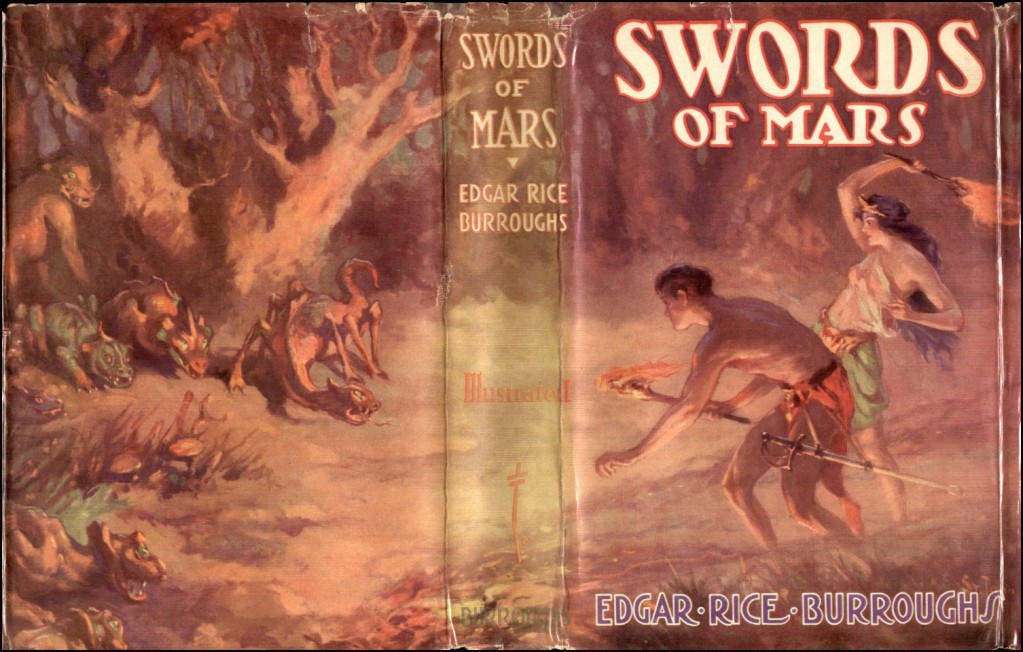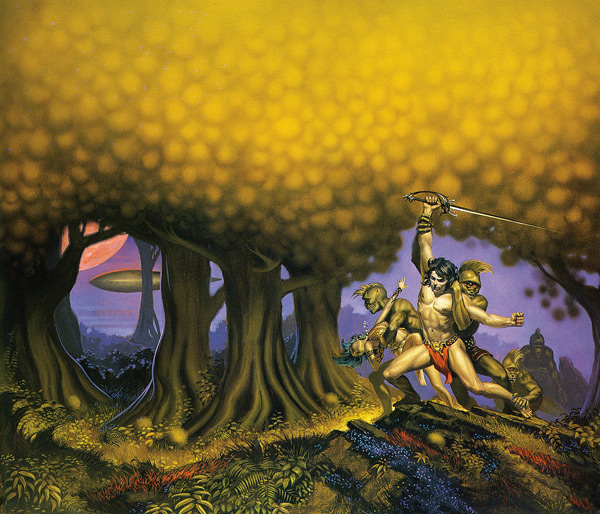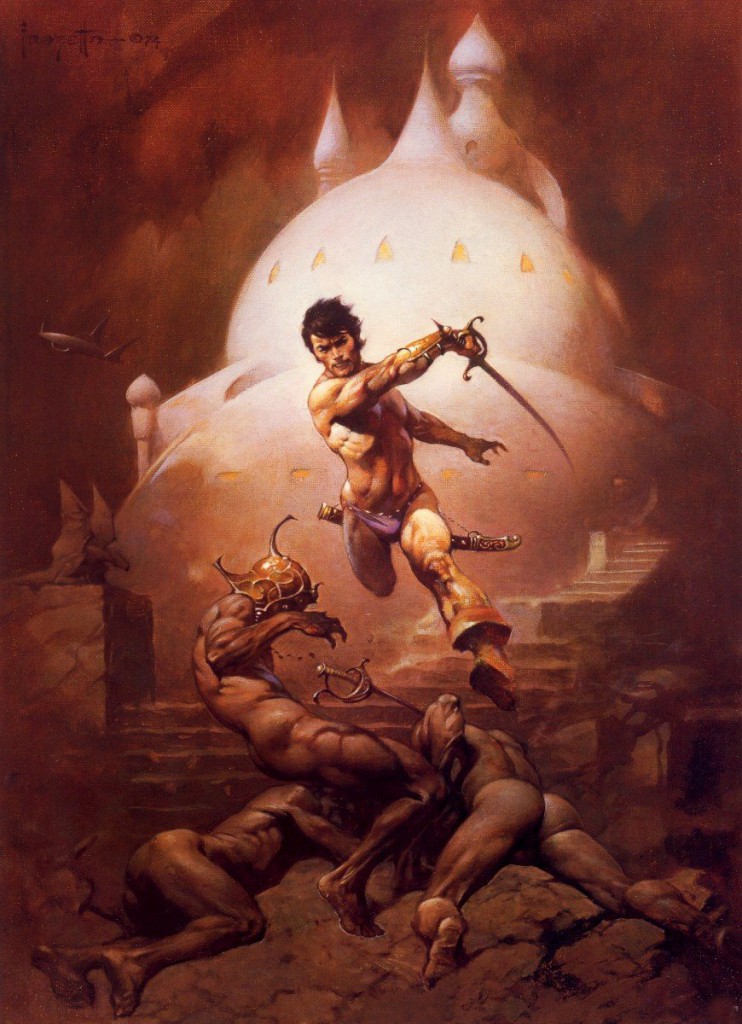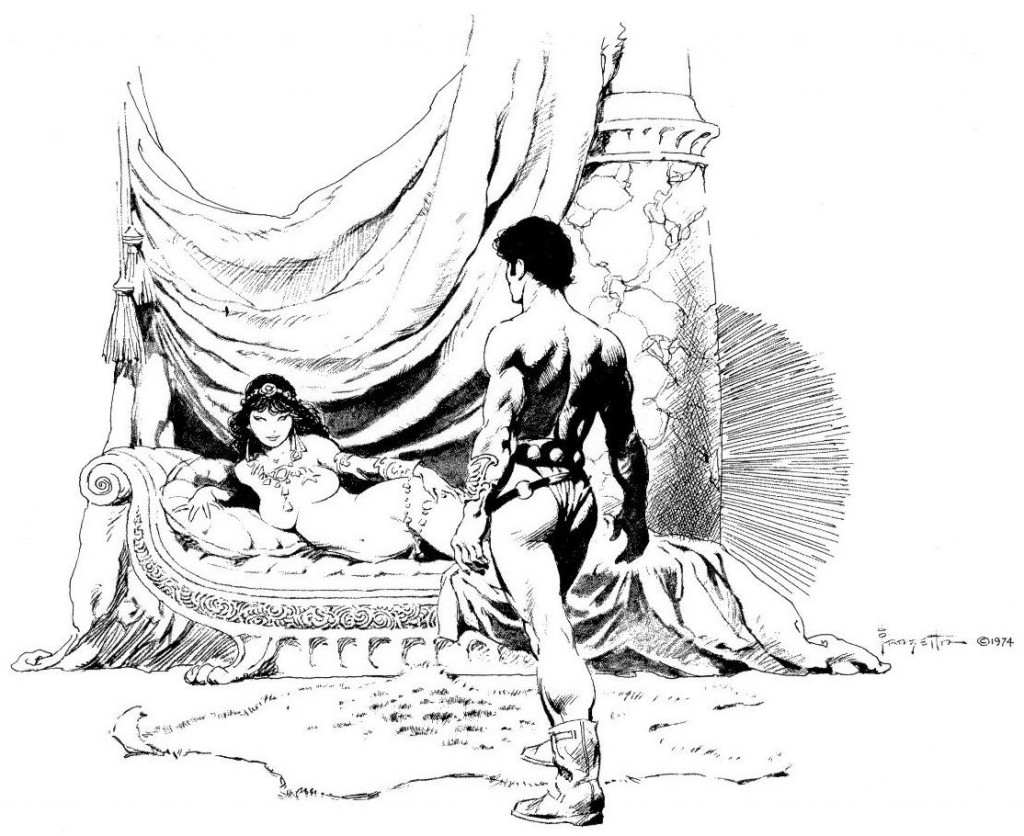Edgar Rice Burroughs’s Mars, Part 8: Swords of Mars
 “But my memories of that great tragedy are not all sad. There was high adventure, there was noble fighting; and in the end there was — but perhaps you would like to hear about it.”
“But my memories of that great tragedy are not all sad. There was high adventure, there was noble fighting; and in the end there was — but perhaps you would like to hear about it.”
Guess who’s back? John Carter, who for the twenty years of real time since The Warlord of Mars has only served the role of a cameo character, is once again the hero and narrator of a Martian novel. And for the first time, he goes off-planet — although only as far as one of Mars’ two miniature moons.
Our Saga: The adventures of Earthman John Carter, his progeny, and sundry other natives and visitors, on the planet Mars, known to its inhabitants as Barsoom. A dry and slowly dying world, Barsoom contains four different human civilizations; one non-human one; a scattering of science among swashbuckling; and a plethora of religions, mystery cities, and strange beasts. The series spans 1912 to 1964 with nine novels, one volume of linked novellas, and two unrelated novellas.
Today’s Installment: Swords of Mars (1934–35)
Previous Installments: A Princess of Mars (1912), The Gods of Mars (1913), The Warlord of Mars (1913–14), Thuvia, Maid of Mars (1916), The Chessmen of Mars (1922), The Master Mind of Mars (1927), A Fighting Man of Mars (1930)
The Backstory
Why did Edgar Rice Burroughs return to John Carter as the hero after exploring other protagonists for so long? My guess: the Great Depression. The Tarzan merchandising empire was just taking off with the huge success of the first Johnny Weissmuller film, Tarzan the Ape Man, but Burroughs received only a flat $75,000 payment for the first two films while MGM raked in millions from them. Concurrently, Burroughs’s independent investment adventures outside of writing were failing. Even with the apparent outward success from Tarzan, times looked uncertain. Adding to the stress, Burroughs’s marriage was collapsing and he and his wife Emma were living separately by the end of 1934. ERB made serious efforts to expand his other franchises (this was the time in which he wrote the first two Venus novels, Pirates of Venus and Lost on Venus), and getting back to John Carter must have felt reassuring, mentally and financially. And indeed, the “Return of John Carter” novel Swords of Mars sold immediately. Burroughs wrote the book rapidly during November and December of 1933, and it appeared serially a year later in the top-tier pulp adventure magazine Blue Book.
This was the first Martian novel published in hardback from the author’s own company, Edgar Rice Burroughs Inc. The hardback appeared in 1936, with a dust jacket cover and interior illustrations by ERB’s first great artist, J. Allen St. John.
The Story
Although the fictional Edgar Rice Burroughs was implied in the last two books, he makes a full return in the prologue. He, like the real ERB, has gone back to the beginning of John Carter’s story: he has gone to explore the White Mountains of Arizona, the region where Captain Carter originally vanished over half a century ago. In his cabin that night, pseudo-ERB receives a sudden visit from the legendary Warlord of Mars, who decides to tell of a great adventure that occurred to him … so ERB won’t have to read a pulp gangster magazine for the night’s entertainment.
John Carter goes in disguise to the troublesome vassal city of Zodonga to stamp out the powerful assassin guild operating there. Under the guise of a soldier-of-fortune named Vandor, Carter gets employment with the inventor Fal Sivas, who had angered the assassin guild under Ur Jan and needs protection.
 Fal Sivas takes Carter into his trust and shows him his spaceship, in which he has planted a mechanical brain, allowing him to control and program the ship entirely through his brain waves. Carter secretly learns to control it. When the assassin guild suddenly kidnaps John Carter’s mate, Dejah Thoris, from Helium and fly off in a second spacecraft created by Fal Sivas’s rival, Gar Nal, the hero uses the first ship to take off in pursuit. He takes with him Zanda, a slave-girl he has sworn to protect, and an insistent young padwar from Helium, Jat Or. Their destination: Mars’s small moon, Thuria.
Fal Sivas takes Carter into his trust and shows him his spaceship, in which he has planted a mechanical brain, allowing him to control and program the ship entirely through his brain waves. Carter secretly learns to control it. When the assassin guild suddenly kidnaps John Carter’s mate, Dejah Thoris, from Helium and fly off in a second spacecraft created by Fal Sivas’s rival, Gar Nal, the hero uses the first ship to take off in pursuit. He takes with him Zanda, a slave-girl he has sworn to protect, and an insistent young padwar from Helium, Jat Or. Their destination: Mars’s small moon, Thuria.
When Carter and his companions land on Thuria, they find their enemies have fallen into the hands of a race of tyrants, the Tarids, who can use mental projection to make themselves invisible and inaudible. Carter joins forces with Umak, a cannibalistic creature of the cat-like race called the Masenas, and tries to knit an alliance with Dejah Thoris’s kidnappers so they can escape the bizarre moon and return to Mars on the telepathic spaceship.
Please re-read that last paragraph. That, ladies and gentlemen, is Edgar Rice Burroughs’s appeal.
The Positives
Swords of Mars shows a decline from the exciting high and excellent characterizations of A Fighting Man of Mars, but it excels in the department of ideas, one of Edgar Rice Burroughs’s great skills as a fantasy and adventure writer.
The Barsoom books are prime examples of the “science fantasy” genre, known then as “scientific romance,” but this is the book with the most emphasis on the “science” half of the equation. Swords of Mars is the science-fiction fan’s ERB novel. It’s amazing to think that we’re already eight books into an eleven-book series taking place on Mars and this is the first time that a spaceship has shown up. But that only makes the telepathically controlled ship that much more intriguing. The ship opens up the novel and permits the first off-Mars adventuring. Burroughs might have felt he had exhausted most of Mars’s terrain possibilities, and here was an ideal solution to that.
The concept of a spaceship that can be “programmed” through brain waves was pretty far-out in the early 1930s — and certainly for the low-tech setting of Barsoom. Burroughs gets plenty of clever use out of the ship, and crafts the two best adventure sequences out of it. The first is the ship’s approach to Thuria, a great departure from the usual action seen in the Barsoom books: an actual “hard SF” (“hard” for ERB, anyway) suspense piece. The second scene is the book’s climactic highlight (although unfortunately not the actual climax) with John Carter trying to maneuver the ship to arrange an escape and rescue from the Tarids’ Tower of Diamonds.
Thuria is an interesting mini-world within a world — or above it. The science behind the moon itself and why the gravity is no different from Mars is riotous, but the twin weird races of the Tarids and the Masenas are inventive successes in a series teeming with them. The physiology of the Masenas — single eye, feline features, arboreally adapted hands, and two sets of different formed mouths — is strange and yet makes sense for an actual creature. The Tarids’ mental cloaking powers make for some unique suspense, since once John Carter figures how to see through their deception, he still has to trick them into believing that he cannot see or hear them.
 Oh, what a relief that the plot begins with something other than the quest for a kidnapped woman! Giving John Carter an espionage assignment against a league of assassins breaks up the plot monotony that runs through most of the Mars books. It doesn’t last, but I will give the book credit for almost reaching the midpoint before a princess gets seized. The assassins and chief villain Ur Jan could’ve sustained a complete novel without having to go into rescue mode.
Oh, what a relief that the plot begins with something other than the quest for a kidnapped woman! Giving John Carter an espionage assignment against a league of assassins breaks up the plot monotony that runs through most of the Mars books. It doesn’t last, but I will give the book credit for almost reaching the midpoint before a princess gets seized. The assassins and chief villain Ur Jan could’ve sustained a complete novel without having to go into rescue mode.
Returning to John Carter’s POV was a risky move, since his character arc reached completion in The Warlord of Mars. But he works surprisingly well in this story as long as the reader accepts that the leader of an entire planet would abruptly leave his duties to conduct a spy mission on his own. A classic “Starship Captain” error, but it does fit Carter’s enormous ego. Using Carter forces ERB to break some conventions, since he couldn’t give the hero a new romantic interest with Dejah Thoris still alive unless he resorted to the Tarzan amnesia trick — and thank Issus he didn’t go that route! Carter brings back his unique voice to the series, and his awesome arrogance makes for fun passages, such as his repeated bullying of Fal Sivas’s pathetic underlings and the taunts he hurls at killers in an alley before he slices them down.
Zanda (and to a lesser extent Ozara, the captive jeddara of the Tarids) offers a clever way around the problem of providing romantic tension in a novel where the hero is already permanently unavailable. Zanda, of course, falls in love with John Carter in his disguise as Vandor. But not only is Carter unable to return Zanda’s love, but Zanda does not know that the man to whom she’s pledged her love is also the man she blames for the death of her parents during Helium’s war against her home city. It puts the hero in a good bind, even though no reader will believe for a second that Vanda will succeed in carrying out her promise to murder Carter if she ever meets him.
The heroes of Mars always work best when they team up non-human allies, like Tars Tarkas and Ghek the rykor. Umak the cat-man continues the tradition, handily overshadowing John Carter’s other “sidekick” Jat Or. The scenes in the cell where John Carter gets to know Umak and learns to communicate with him are among the best written in the novel, showing excellent use of suspense when Carter isn’t certain what to make of the strange creature with whom he’s imprisoned.
Swords of Mars returns to the “racial cooperation” theme that was so important to some of the earlier books. But here it’s not only different races working together, it’s avowed enemies who have to bury their grievances temporarily to fight against the Tarids. This makes the main “jailbreak” sequence during the last quarter of the book more tense and intriguing. The resolution to this alliance is unsurprising — somebody will turn traitor, somebody else will change allegiance — but it works while it’s happening.
The prologue with pseudo-ERB in Arizona is fantastic. The evocation of Arizona and the vanished Apaches as a parallel for dying Mars and its soon-to-be-extinct green men has a powerful real-world echo, both for the Apaches and for Burroughs reflecting on his earlier career. That pseudo-ERB settles in at night with a lurid gangster magazine about “kidnappings” is a deft touch of self-parody. At this later point in his career, Burroughs had developed a good sense of self-deprecation.
The final sentence of Swords of Mars is one of the best sign-offs in any Burroughs novel; it almost compensates for the problematic last chapter.
The Negatives
Intriguing scientific concepts, an exciting new locale, a fresh way to get the plot underway … and ERB still ends up with a “rescue the princess” story! And he introduces it halfway into the novel in epically clumsy fashion. The assassin guild makes a sudden switch in their plan to kidnapping a foreign princess. It turns out there is a second amazing ship built by a rival inventor who has only received brief mention before. John Carter races back to Helium only to find that the assassins somehow got there first and snatched Dejah Thoris away. John Carter flies back to Zodanga to grab the other ship. All this occurs in barely a chapter and a half, enough to give readers motion sickness from this abrupt shaking of the story to knock it into a new form.
It seems the plot ERB wanted to tell all along was about John Carter using a spaceship to pursue the fiends who kidnapped his princess to one of Mars’s moons. But nearly half of the story has nothing to do with this except to introduce the concept of the spaceship, making it feel like Burroughs changed his mind in the middle of dictating the novel and didn’t want to rewrite (re-dictate?) the beginning to fit the new plot. But since the assassin guild and the invention of the brain ship make a good foundation for a story, the best path might have been to come up with a fresher motivation to drive John Carter to Thuria than the moldy contrivance of having his mate abducted.
And what happened to Fal Sivas’s original threat to conquer Mars and then attack other planets? That idea gets me pretty excited, but it never comes up again after its first mention when the inventor shows John Carter the ship.
 Burroughs fumbles the ending with a rushed yet tensionless last chapter. Major conflicts get dispensed with flippant sentences, new locations rush past, and the arc of the story resolves in an action-free way. Ur Jan makes an unbelievable switch in allegiance, and the dramatic tension for both Vanda and Ozara are simply dismissed. This is the most disappointing close for a Mars novel since The Chessmen of Mars. Burroughs seemed to have a lock on a strong finale with the escape attempt from the Tarids onboard the spaceship, but tossing in yet another abduction carries the story too far and with little support left.
Burroughs fumbles the ending with a rushed yet tensionless last chapter. Major conflicts get dispensed with flippant sentences, new locations rush past, and the arc of the story resolves in an action-free way. Ur Jan makes an unbelievable switch in allegiance, and the dramatic tension for both Vanda and Ozara are simply dismissed. This is the most disappointing close for a Mars novel since The Chessmen of Mars. Burroughs seemed to have a lock on a strong finale with the escape attempt from the Tarids onboard the spaceship, but tossing in yet another abduction carries the story too far and with little support left.
John Carter’s return necessarily brings with it a few problems. Ignoring the illogic of the Warlord of an entire planet risking his life on a standard infiltration mission — this is fairly “in character” for him — Carter’s biggest limitation is that he completed his journey in his original trilogy and no longer has a personal story to follow. Because Carter is already romantically paired off with Dejah Thoris (ERB never broke a romantic couple apart once the deal was sealed) there isn’t any new “romance” in this scientific romance. Dejah Thoris gets tossed in as kidnap bait, but that’s not romantic tension, since Dejah Thoris hardly appears in the story and Carter spends most of his time with Zanda and then Ozara, both of whom are dramatic dead ends.
Dejah Thoris is completely wasted in Swords of Mars. She gets the plot moved to Thuria, but doesn’t actually appear until two-thirds into the story, and then does nothing but act as scenery, standing unheard and unremarked in group scenes. John Carter doesn’t even exchange words with her when he finds her on Thuria! This further makes me wish that ERB had retooled the beginning of the story with the assassin guild to get his heroes to Mars for a reason other than rescuing Dejah Thoris.
Jat Or is a mostly useless secondary hero, and John Carter deciding to take the young man along on the rescue mission seems arbitrary. Why not select one of the many skilled warriors from past adventures? But once Jat Or boards the spaceship and meets Zanda, Burroughs’s plan is obvious, and routine: Zanda can’t end up with John Carter, and since she has to end up with somebody (those are the ERB rules), here’s Jat Or to fill the role. Honestly, it makes me wish that one or the other got a tragic death in the story to add a different punch to the tale other than the requisite “they married and lived happily ever after.”
The ideas still pop, but a lot of the action is losing its fizz. Burroughs’s flair for duel scenes is subdued and bit listless now. Some of it may be the fault of John Carter being too damn good at everything so that the danger is never fully convincing. It feels a long time since we’ve seen a superb sword duel — probably back to the conclusion of The Warlord of Mars.
Swords of Mars may have more science-fiction elements in it than the other books, but that doesn’t mean the science is any more accurate. The telepathic spaceship gets a vague enough explanation to make sense, but Fal Sivas’s theory of “compensatory adjustment of masses” to explain why people shrink down to nine inches high when they fly to Thuria is flat-out hilarious. I can’t tell if Burroughs thought this was a fantastic idea or he just needed a workaround to get rid of the consequences of his characters adventuring on a moon only seven miles in diameter. Either way, it’s ludicrous — even for early magazine SF.
A minor point, but Swords of Mars is the most generic title of the series. It has no specific connection to the story; any of the Mars novels could be called Swords of Mars. The same can be said about A Fighting Man of Mars, but that’s at least an unusual title with some snap. If I were ERB’s editor, I would’ve asked him to change the title to The Brain Ships of Mars or Assassins of Mars.
Craziest Bit of Burroughsian Writing: “Sometimes I feel that I am entitled to very little credit for my countless successes in mortal combat. Always, it seems to me, and it certainly must appear even more so to my opponents, my flashing blade is a living thing inspired to its marvelous feats by a power beyond that of mortal man.”
Best Moment of Heroic Arrogance: John Carter chooses to take on a massive assassin guild entirely on his own, even though he has the resources of the whole planet at his call.
Times a “Princess” (Female Lead) Gets Kidnapped: 3
Best Creature: The Mansenas
Most Imaginative Idea: The telepathy-guided spaceship.
ERB at His Sly Best: “I was not sleepy; and so, after I had undressed, I arranged a kerosene lamp near the head of my bunk and settled myself for the enjoyment of a gangster story of assassination and kidnapping.”
Should ERB Have Continued the Series? No. I sense diminishing returns, and with John Carter back as the hero, it feels as if Barsoom has come full circle.
Next: Synthetic Men of Mars
Ryan Harvey is one of the original bloggers for Black Gate, starting in 2008. He received the Writers of the Future Award for his short story “An Acolyte of Black Spires,” and his stories “The Sorrowless Thief” and “Stand at Dubun-Geb” are available in Black Gate online fiction. A further Ahn-Tarqa adventure, “Farewell to Tyrn”, is currently available as an e-book. Ryan lives in Los Angeles, California. Occasionally, people ask him to talk about Edgar Rice Burroughs or Godzilla in interviews.
I’ve really been enjoying this series of reviews, Ryan. While I can’t argue with any of your downside points, Swords of Mars was the very first Barsoom novel I read and I will always have a soft spot for it. It works well as an introduction to the series as a whole if you’ve never encountered the original trilogy and makes you want to read more.
But, really, what was Burroughs’ thing with princesses? I just read The Lost Continent and darned if he didn’t manage to fit a princess into a post-apocalyptic Europe.
Keep up the great work!
And what do you have to look forward to next? Synthetic Men of Mars, Llana of Gathol and John Carter of Mars. Ummm . . .
How true about continuation. . . it has been my observation that a ERB novel needs to have the hero fall in love and only win the heroine at the end. To continue with the same hero after he won it — doesn’t go on. Except in the second two Mars books, but he doesn’t pull it off again.
[…] Next Up: Swords of Mars […]
[…] in a stunning cliffhanger, a pack of Red Martians from the troublesome vassal city of Zodanga attempted to kidnap her and carry her back to […]
[…] paths with new heroes. John Carter will not return to the protagonist role until the eighth book, Swords of Mars, published twenty-one years […]
[…] (1916), The Chessmen of Mars (1922), The Master Mind of Mars (1927), A Fighting Man of Mars (1930), Swords of Mars (1934–35), Synthetic Men of Mars […]
[…] (1916), The Chessmen of Mars (1922), The Master Mind of Mars (1927), A Fighting Man of Mars (1930), Swords of Mars (1934–35), Synthetic Men of Mars (1938), Llana of Gathol […]